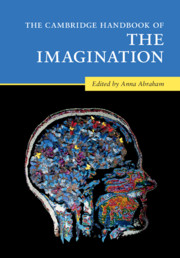Book contents
- The Cambridge Handbook of the Imagination
- The Cambridge Handbook of the Imagination
- Copyright page
- Dedication
- Contents
- Figures
- Contributors
- Acknowledgments
- 1 Surveying the Imagination Landscape
- Part I Theoretical Perspectives on the Imagination
- Part II Imagery-Based Forms of the Imagination
- 12 The Visual Imagination
- 13 Musical Imagery
- 14 Neurophysiological Foundations and Practical Applications of Motor Imagery
- 15 Temporal Mental Imagery
- 16 Emotional Mental Imagery
- 17 Multisensory Perception and Mental Imagery
- 18 Evocation: How Mental Imagery Spans Across the Senses
- Part III Intentionality-Based Forms of the Imagination
- Part IV Novel Combinatorial Forms of the Imagination
- Part V Phenomenology-Based Forms of the Imagination
- Part VI Altered States of the Imagination
- Name Index
- Subject Index
- References
17 - Multisensory Perception and Mental Imagery
from Part II - Imagery-Based Forms of the Imagination
Published online by Cambridge University Press: 26 May 2020
- The Cambridge Handbook of the Imagination
- The Cambridge Handbook of the Imagination
- Copyright page
- Dedication
- Contents
- Figures
- Contributors
- Acknowledgments
- 1 Surveying the Imagination Landscape
- Part I Theoretical Perspectives on the Imagination
- Part II Imagery-Based Forms of the Imagination
- 12 The Visual Imagination
- 13 Musical Imagery
- 14 Neurophysiological Foundations and Practical Applications of Motor Imagery
- 15 Temporal Mental Imagery
- 16 Emotional Mental Imagery
- 17 Multisensory Perception and Mental Imagery
- 18 Evocation: How Mental Imagery Spans Across the Senses
- Part III Intentionality-Based Forms of the Imagination
- Part IV Novel Combinatorial Forms of the Imagination
- Part V Phenomenology-Based Forms of the Imagination
- Part VI Altered States of the Imagination
- Name Index
- Subject Index
- References
Summary
Mental imagery is what we experience when we imagine seeing a specific object, hearing a particular sound, or feeling a particular touch, and it is perhaps the most fundamental aspect of our imagination. Historically, research on mental imagery has explored the phenomenological and neurological similarities between mental imagery and sensory perception to understand the quasi-perceptual nature of these conjured “images” we experience in the “mind’s eye.” However, this line of research has traditionally focused on the similarities of mental imagery and perception within each sensory modality, and the relationship between mental imagery in one sense and its effects on perception in another sense or on our perception of the world around us as a whole has largely been ignored. This chapter will extend the study of the relationship between mental imagery and perception into a multisensory context, and utilize insights from research in neuroscience and multisensory perception to explore how mental imagery in one sense can affect ongoing perception in another. The chapter will also examine the similarities in how the brain processes and integrates imagined and real crossmodal sensory stimuli. Lastly, the chapter will discuss how the integration of mental imagery and real sensory stimuli can lead to brain plasticity across the senses and change how we perceive the world around us in the future.
- Type
- Chapter
- Information
- The Cambridge Handbook of the Imagination , pp. 258 - 275Publisher: Cambridge University PressPrint publication year: 2020
References
- 1
- Cited by

